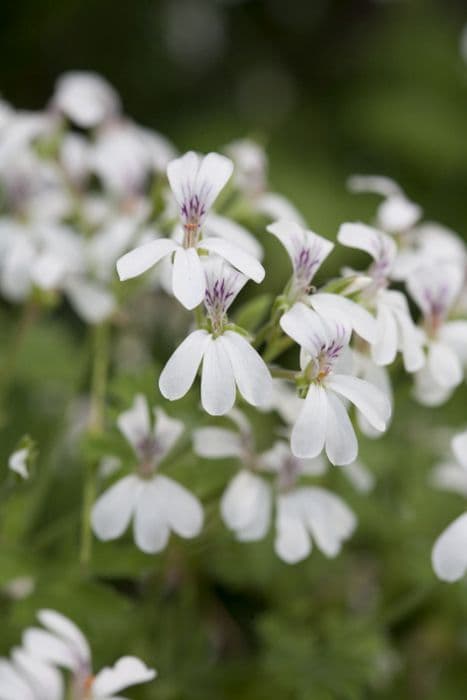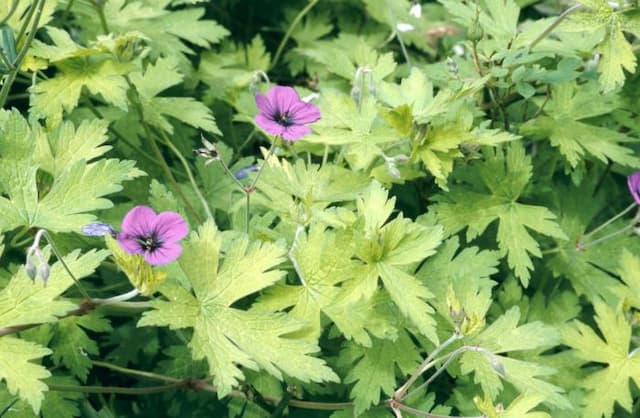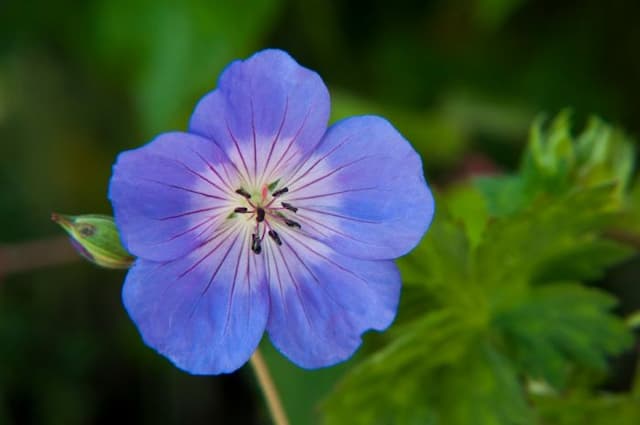Scented geranium Pelargonium 'Lilian Pottinger' (Sc)

ABOUT
Pelargonium 'Lilian Pottinger' is a distinctive variety displaying a lush display of foliage and blooms. The plant is characterized by its vibrantly colored flowers, usually presented in striking shades that catch the eye. Each flower is comprised of rounded petals that overlap, creating an almost rounded silhouette when viewed en masse. The intensity and hue of the color can vary, offering a delightful display that can bring liveliness to any setting. The foliage of 'Lilian Pottinger' is equally notable, with leaves that are attractively shaped, often having a soft, velvety texture. The green of the leaves offers a pleasing contrast to the brightness of the flowers, and they may also have unique zonal patterns or markings, which add to the ornamental appeal of the plant. The leaves are usually borne on stems that hold them outwards and upwards, allowing for a full appreciation of their shape and form. In terms of growth habit, 'Lilian Pottinger' tends to form a bushy clump, with the stems and foliage creating a dense and lush appearance. This growth pattern allows for an abundance of flowers to emerge, offering a sustained and prominent display throughout its blooming period. The overall visual impact of the plant is one of vibrant color and pleasing texture, making it a popular choice for gardeners seeking to add an aesthetically pleasing element to their gardens or indoor spaces. Please note that details about the size of the plant have been intentionally omitted.
About this plant
 Names
NamesFamily
Geraniaceae
Synonyms
Lilian Pottinger Geranium, Lilian Pottinger Pelargonium
Common names
Pelargonium 'Lilian Pottinger'
 Toxicity
ToxicityTo humans
The Pelargonium 'Lilian Pottinger' commonly known as a type of geranium, is generally considered non-toxic to humans. However, ingestions of the plant can cause minor symptoms such as nausea, vomiting, and diarrhea. Although severe poisoning is rare, it is advisable to keep the plant out of reach from small children who might be tempted to ingest parts of the plant.
To pets
Geraniums, including the Pelargonium 'Lilian Pottinger', are known to be toxic to pets, particularly cats and dogs. If ingested by pets, it can cause symptoms such as vomiting, anorexia, depression, and dermatitis. In some cases, ingestion can lead to more serious conditions like kidney failure, especially in cats. It is recommended to keep geraniums away from pets to avoid the risk of poisoning.
 Characteristics
CharacteristicsLife cycle
Perennials
Foliage type
Evergreen
Color of leaves
Green
Flower color
Pink
Height
1-2 feet (30-60 cm)
Spread
1-2 feet (30-60 cm)
Plant type
Herb
Hardiness zones
9
Native area
South Africa
Benefits
 General Benefits
General Benefits- Beautification: Pelargonium 'Lilian Pottinger' adds aesthetic value to gardens and homes with its vibrant and colorful flowers.
- Aromatherapy: The scented varieties of geraniums can contribute to a soothing and relaxing environment, often used in aromatherapy for their mood-enhancing fragrance.
- Easy Maintenance: Geraniums are generally easy to care for, making them suitable for gardeners of all skill levels.
- Drought Resistance: These plants are fairly drought-tolerant, requiring less water than many other flowering plants, which makes them eco-friendly and low-maintenance.
- Pest Deterrent: The aroma of some geraniums can act as a natural deterrent for certain pests, potentially reducing the need for chemical repellents.
- Long Blooming Period: Geraniums often have a lengthy blooming season, providing color in a garden or home for extended periods.
- Adaptability: They can grow in a variety of climates and conditions, from outdoor garden beds to indoor pots, making them versatile additions to many settings.
 Medical Properties
Medical Properties- This plant is not used for medical purposes.
 Air-purifying Qualities
Air-purifying QualitiesThis plant is not specifically known for air purifying qualities.
 Other Uses
Other Uses- Ink Production: The vivid colors of the geranium's flowers can be used to create natural dyes for inks.
- Artistic Inspiration: Artists may be inspired by the beauty of the geranium and incorporate its form or color into paintings, drawings, and textiles.
- Educational Tool: Geraniums can be used in schools or educational programs to help teach botany and the life cycle of plants.
- Repellent: The strong scent of geranium leaves is said to repel mosquitoes when rubbed on the skin or when the plant is grown nearby outdoor seating areas.
- Photography Subject: The Pelargonium 'Lilian Pottinger' is an ideal subject for photographers wanting to capture the intricate beauty of flowers.
- Scented Letters: Infusing writing paper with the scent of geranium leaves for a unique and personal touch to handwritten letters.
- Floral Arrangements: Geranium flowers can add color and volume to floral arrangements and bouquets.
- Crafting Potpourri: The flowers and leaves, when dried, can be added to potpourri mixtures for their color and fragrance.
- Plant Companion: Geraniums can be planted alongside certain vegetables as companion plants to deter pests due to their strong scent.
- Fragrance Industry: Essential oils extracted from geraniums can be used in perfumery and aromatherapy products.
Interesting Facts
 Feng Shui
Feng ShuiThe Geranium is not used in Feng Shui practice.
 Plant Symbolism
Plant Symbolism- Comfort and Healing: Pelargoniums, commonly known as geraniums, are often associated with comfort due to their pleasant scent which is believed to promote relaxation and emotional healing.
- Friendship: Giving geraniums as a gift may symbolize a simple expression of friendship or a wish for deeper human connection.
- Good Health: Due to their use in traditional medicine and the belief in their beneficial properties, geraniums may be seen as a symbol of good health and well-being.
- Fertility and New Life: Geraniums can also represent fertility and the creation of new life because they are prolific bloomers and can easily be propagated from cuttings.
- Happiness and Positive Emotions: The bright and varied colors of geranium flowers are often associated with cheerfulness, happiness, and uplifting emotions.
 Water
WaterGeraniums, including the 'Lilian Pottinger', prefer to be watered deeply but infrequently, allowing the soil to dry out slightly between waterings. During active growing seasons like spring and summer, water your plant about once a week with about 8-16 ounces of water, depending on the size of the pot and the environmental conditions. Always avoid waterlogging as this can lead to root rot. In winter, reduce the frequency to every other week, as the plant requires less moisture during dormancy.
 Light
LightGeraniums thrive in bright, indirect sunlight. The ideal spot for 'Lilian Pottinger' geranium is near a window that receives at least 6 hours of sunlight daily, but with some protection from the harsh afternoon sun. East or west-facing windows are typically the best locations for these plants to obtain the optimal amount of sunlight without the risk of scorching.
 Temperature
TemperatureGeraniums like 'Lilian Pottinger' prefer temperate conditions with daytime temperatures between 65°F and 75°F, and nighttime temperatures no lower than 50°F. They can tolerate a maximum of around 80°F, but temperatures beyond this can stress the plant. These geraniums should not be exposed to temperatures below 30°F, as they are not frost hardy.
 Pruning
PruningPrune your 'Lilian Pottinger' geranium to encourage bushier growth, remove dead or yellowing leaves, and promote better air circulation. The best time to prune is in early spring or just after the plant has finished blooming. Cut back up to one-third of the plant, making your cuts above a leaf node. Regular deadheading of spent flowers will also help the plant to produce new blooms.
 Cleaning
CleaningAs needed
 Soil
SoilFor geranium 'Lilian Pottinger', the best soil mix is one that is well-draining and fertile, comprising a mixture of peat, perlite, and potting compost. The ideal pH for this plant ranges between 6.0 and 7.0.
 Repotting
RepottingGeranium 'Lilian Pottinger' should be repotted every one to two years to ensure the soil remains nutrient-rich and to refresh the root environment.
 Humidity & Misting
Humidity & MistingGeranium 'Lilian Pottinger' thrives in moderate humidity levels around 40-60%, avoiding excessively dry or humid conditions.
 Suitable locations
Suitable locationsIndoor
Place in bright, indirect light and water when topsoil is dry.
Outdoor
Needs sunlight, sheltered spot, and well-draining soil; frost-free.
Hardiness zone
10-11 USDA
 Life cycle
Life cycleThe plant Pelargonium 'Lilian Pottinger', commonly known as Scented Geranium, begins its life cycle when its seeds are sown in well-draining soil with ample sunlight. Upon germination, seedlings emerge and gradually develop into young plants with characteristic fragrant foliage. As the plant matures, it enters an active vegetative growth phase, producing a bushy structure with numerous leaves and branching stems. During its flowering stage, typically in spring and summer, the Scented Geranium displays clusters of small, vibrant flowers that attract pollinators. Following pollination, the plant may produce seeds, completing its reproductive cycle. Throughout its life, the Scented Geranium requires regular pruning to encourage bushier growth and may be overwintered indoors in colder climates to protect it from frost.
 Propogation
PropogationPropogation time
Spring-Summer
Propogation: Pelargoniums, commonly known as geraniums, are most readily propagated through stem cuttings. For the Pelargonium 'Lilian Pottinger', the ideal time to take cuttings is late summer or early autumn. This period gives the new plants enough time to establish before winter. To propagate via cuttings, a healthy non-flowering stem about 4 to 6 inches long (10 to 15 centimeters) is cut just below a leaf node. The lower leaves are removed, and the cut end is dipped in rooting hormone powder to encourage root growth. It is then planted in a mix of equal parts peat and perlite or a well-draining potting mix. The cutting should be kept moist and in indirect light until roots have formed, which typically takes a few weeks. After rooting, it can be transplanted to a more permanent location or pot.









